Menus
- Last real series Zundapp
- In 1978 it achieved the best torque values
- Thermosiphon – no water pump
- If you are looking for fun, you switch
- A good 25 hp on the crankshaft
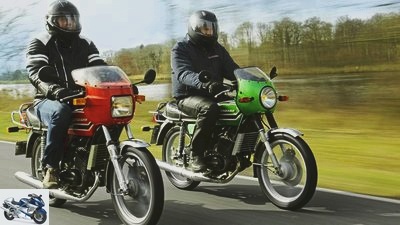
Sven Krieger
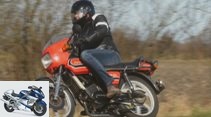
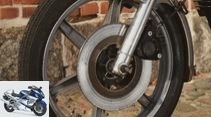
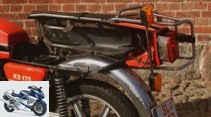
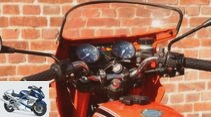
23 photos
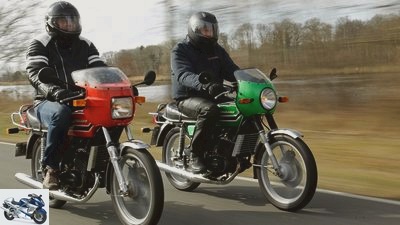
Sven Krieger
1/23
In 1976, Zundapp wanted to put out the Japanese conflagration with the help of a liquid-cooled 17 HP machine. In vain: the KS 175 was the last real series motorcycle from this major German brand.
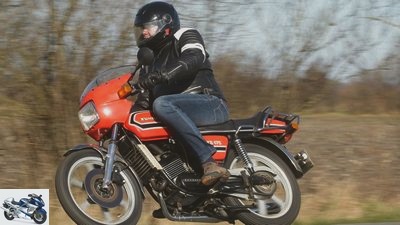
2/23
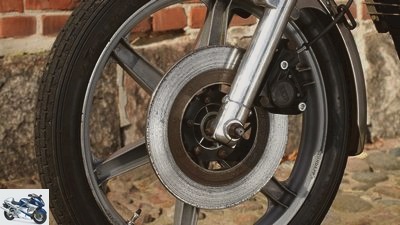
Sven Krieger
3/23
Brembo’s easy-to-dose standard pliers are completely sufficient for the lightweight KS
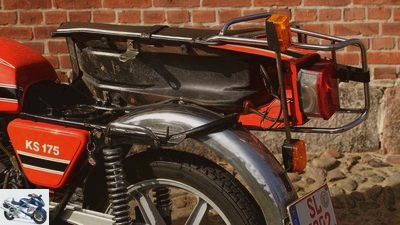
Sven Krieger
4/23
Seat shell, side cover, rear apron: a lot of sheet metal where there is otherwise plastic. The rear fender is chrome-plated, the front made of stainless steel
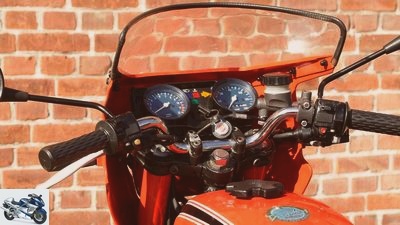
Sven Krieger
5/23
Even back then, the Japanese were better at the fittings, and their instruments and displays also looked more pleasant
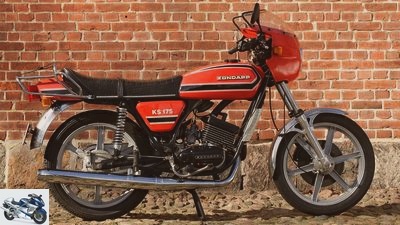
Sven Krieger
6/23
Zundapp KS 175, model 1979
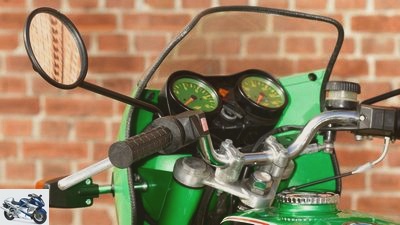
Sven Krieger
7/23
In addition to the fairing, indicators and seat, the first series carries
the KS 175 also has other fittings and instruments than the second
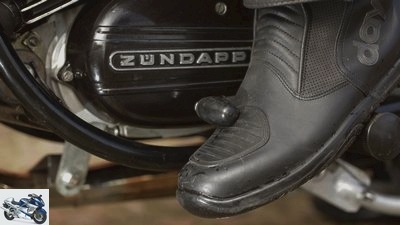
Sven Krieger
8/23
If you pay attention to the lettering, you can gauge how long it is from the starting position …
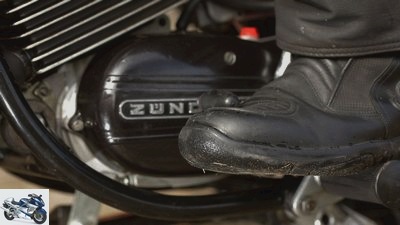
Sven Krieger
9/23
… until the gear engages
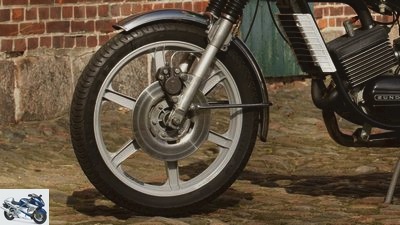
Sven Krieger
10/23
Initially the same fork as the 125cc. The Grimeca brake caliper looks blunt
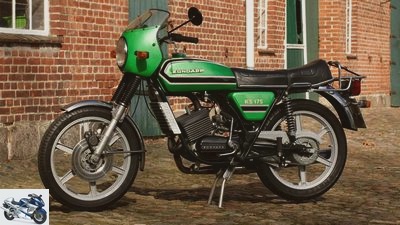
Sven Krieger
11/23
Zundapp KS 175, model 1977
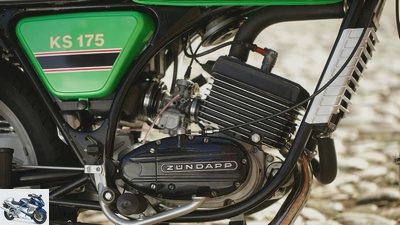
Sven Krieger
12/23
The thermosiphon cooling works without a pump, the heated water simply rises up into the cooler and runs down to the double-walled cylinder
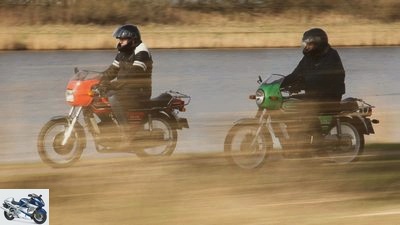
13/23
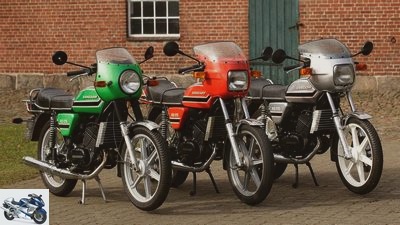
Sven Krieger
14/23
There weren’t any more colors. The differences between the first series, built until 1978, and the second series are striking. Production ended in 1981, but deliveries continued until 1983
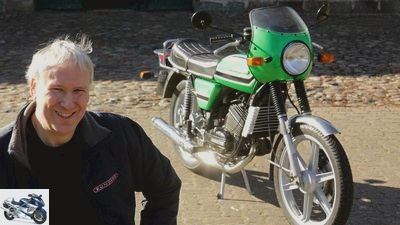
Sven Krieger
15/23
Dirk Struve owner of the KS 175 from the first series:
I can’t get enough of Zundapp collecting, and the late two-stroke engines are a main focus of my interest.
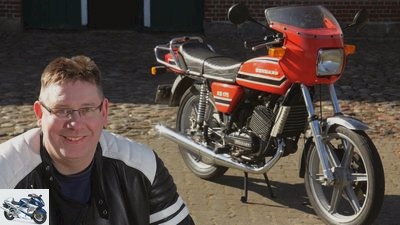
16/23
Klaus Moller owner of the KS 175 from the last series:
Your external lightness has always fascinated me. The 175 looks like a light motorcycle, but conveys a completely different driving experience.
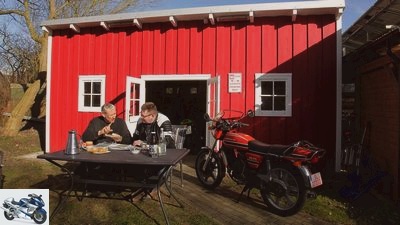
Sven Krieger
17/23
On the other side of the Main Line, Zundapp often counted more than in the Bavarian homeland. Even across the Elbe, as two enthusiastic collectors prove.
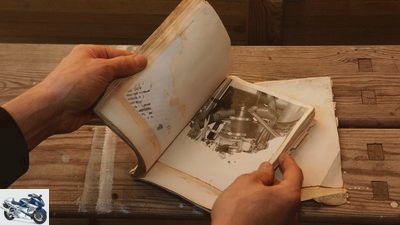
Sven Krieger
18/23
The very rare typewritten manual
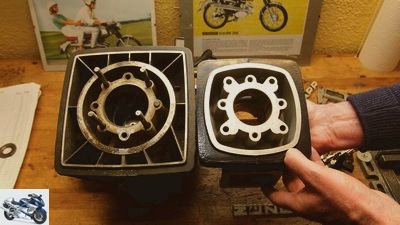
Sven Krieger
19/23
The KS 175 cylinder with, next to it one produced by Laverda without a double wall
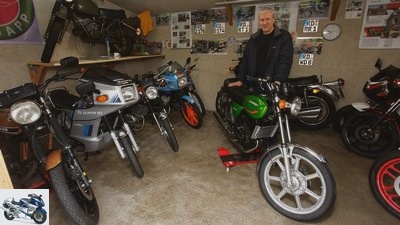
Sven Krieger
20/23
One of two and a half Bundeswehr prototypes hangs under the ceiling in Dirk Struve’s shed
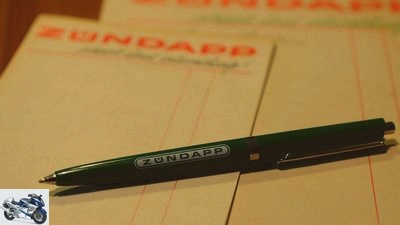
Fred Siemer
21/23
If Klaus Moller wants, he can write his letters on original Zundapp paper …

Fred Siemer
22/23
… and decorate his house with original Zundapp pennants.
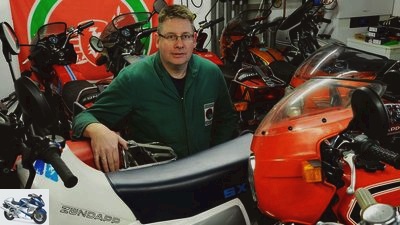
Fred Siemer
23/23
Or he can tinker his Zundapps in the original smock. But he doesn’t want to. Klaus just wants to play.
Classic motorcycle Zundapp KS 175
Last real series Zundapp
Content of
With the help of a liquid-cooled 17 HP machine, Zundapp wanted to extinguish the Japanese wildfire in 1976. In vain: the KS 175 was the last real series motorcycle from this major German brand.
B.With all his enthusiasm for motorcycles in general and well-made two-stroke engines in particular, Siegfried Rauch always maintained a deep level of prudence. Issue 18/1976 of MOTORRAD shows each of these traits: There the long-time editor-in-chief welcomes the fresh Zundapp motorcycles and is delighted that, thanks to the new German insurance regulations, they can finally free themselves from the displacement trap and again develop more everyday two-stroke virtues. Instead of squeezing as much power as possible from the given cubic capacity in order to be competitive in the corresponding insurance class, 17, 27 or 50 hp could now be produced from no matter how much cubic capacity. This beneficial development led the Zundapp people to replace their somewhat nervous 125cc with an equally powerful 175cc with a more pleasant torque curve, our age thought that was great.
Buy complete article
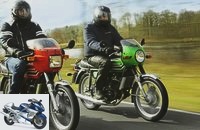
Classic motorcycle Zundapp KS 175
Last real series Zundapp
Zundapp KS 175 cost 3,880 marks
What does all of this have to do with the KS 175? Well, in the aftermath, people tend to be nostalgic, and although it is well known that no one has made efforts like the one demanded by Rauch, this nostalgia still whispers not only to lovers of the brand that Zundapp missed a great opportunity back then. The management neglected its 17 hp novelty and – above all – the 350 series, which was presented at the same time but never went into production, and practically completed its own decline despite existing customer interest.
The fact is: regardless of the question of whether Zundapp would have had enough money for a completely new engine like the 350 twin in 1976, there was no stopping it, because every German motorcycle had to be about as expensive as a twice as powerful one from the Far East.
Our wonderful KS 175 was the proof. It actually came on the market in 1977 and cost 3,880 marks. What remained the worst of its few disadvantages, technically it was always at the top of the 17 hp field. Favorable tax and insurance tariffs ensured a colorful hustle and bustle of two-stroke single-cylinders (including Harley-Davidson SS 175, Hercules K 125 S, KTM Comet 125 RS, Maico MD 125, MZ TS 250), four-stroke singles (Benelli 250 Sport Spezial, Kawasaki Z 200), two-stroke twin-cylinder (Malanca 125, Suzuki GT 185, Yamaha RD 200) and four-stroke twins (Honda CB 200 and 250J, Yamaha XS 250). Which would only name those pure road machines that really exhausted the horsepower limit, performance deniers and enduros were added. All of these machines managed 110 to a good 120 km / h, so they could do very well beyond the motorway.
In 1978 it achieved the best torque values
The Zundapp KS 175 was able to do a little more, namely reconcile sport and everyday life. This was also the development goal when the order was received around 1974 to civilize the existing 125cc five-speed engine with the help of thermosiphon cooling and a moderate increase in displacement. The stroke of 54 millimeters remained, but the piston diameter grew from 54 to 62 millimeters, which then results in exactly 163 cm³. The carburetor was no longer supplied by Bing, but by Mikuni, whose diameter grew by one to 28 millimeters. As desired, the performance curve of the large KS between 2,500 and a good 5,000 rpm strives much more steeply upwards than that of the 125, but both reach their peaks of 17 hp at a comparable speed level.
The torque curve of the Zundapp KS 175 is also more harmonious, and driving is much more relaxed. A few figures: Among eight candidates, the KS 175 achieved the best torque values (50 to 100 km / h: 17 s) in the MOTORRAD comparison test at the beginning of 1978, at top speed (lying 125.9 km / h) and acceleration (0 to 100 km) / h: 11.4 s) it was also ahead, ahead of the two-stroke twins from Suzuki and Yamaha. Compared to the two-stroke single-cylinder engines, it looked like the best of two worlds, combining a lot of the rich pulling power of an MZ 250 with a few splashes of the energetic temperament of a Hercules 125.
Thermosiphon – no water pump
Unlike the Zundapp KS 175, the Nuremberg eight-liter Hercules 125 unit is annoying with the acoustic behavior of a small motorcycle. One that is air-cooled, to be more precise, because the shrill whirring noise at high speeds is generated by the vibrations of the large cooling fins. No connecting bars or rubber buffers help, only a water jacket helps. The Munich-based company had already prescribed this to their KS 50 watercooled moped at the IFMA in Cologne in 1972, and now they have put it on the 175 engine block. By the way, behind the mysterious term thermosiphon there is … nothing! More precisely: the waiver of a water pump. The heated water rises by itself and is fed into the large radiator via the fat hose on the cylinder cover. From there it flows back down to the cylinder base. The disadvantage: In order to keep the flow speed halfway high, the amount of water must not be particularly large, load peaks – low speed, for example at high speeds – can therefore cope with circulation cooling much better. The cylinder body, which is open at the bottom, is designed as a double jacket on the Zundapp, which means that the actual cylinder is connected by a number of cooling fins with the shell visible from the outside.
Because Zundapp’s off-road factory racers were air-cooled until the end, it can be assumed that the aluminum water jacket was primarily intended to reduce noise emissions. Which was quite successful, even if the spontaneously starting engine doesn’t exactly whisper. If you complain about your willingness to perform in a bold two-stroke, the choke doesn’t need half a minute. Shift travel and precision of the draw-wedge gear have been reviled often enough, at this point it is simply countered with the amazing pulling power of the two-stroke single. You don’t have to change gear very often, at least not around Rendsburg, where MOTORRAD Classic asked three Zundapp KS 175s for a rendezvous: The red belongs to the second series and belongs to Klaus Moller, the green to the first. Its owner, Dirk Struve, quickly knitted a silver one from parts of his considerable warehouse, so all the colors supplied are available.
If you are looking for fun, you switch
The red Zundapp KS 175 is now happily accelerating out of town on the fourth. At about the level of the nominal speed, the fifth then makes good connections, but proves to be a little fun brake. A little too long, sitting upright it gets quite tough even before 110 km / h. If you duck a little, you will gradually come close to 120 km / h. On the other hand, you can open the gas even in high gear at 50 without the engine starving completely. Can’t get down with a good 3,000 tours, draw hope at 4,000, confidence at 5,000, only to express joy again shortly after with happy moaning. However, sober numbers make it clear how academic such a pull-through test is: In fifth gear, the Zundapp needs 17 to 100 km / h, as already mentioned, in fourth a whole 11.5 seconds. So if you are looking for fun, switch. Draw wedge or not.
Which then means that the sought-after and actually found curves behind the Kiel Canal are aimed at with a swing in fourth, if not third gear. Even straight ahead, the frame, which was adopted from the Zundapp KS 175 and thus principally from the all-terrain device, is bolt-stable, the speed is adjusted with the easy-to-dose Brembo pliers, the KS angles slightly but not wobbly. At the apex of the bend, there should be 5,500 rpm again, then neither bumps nor grooves can diminish this pure joy of ease. It’s great how the KS circles through bends, and that’s why Klaus and Dirk swear by their large Zundapps. In addition, a firm, not uncomfortable suspension as well as a comfortable sitting position for tall people keep the fun going.
A good 25 hp on the crankshaft
But there is still better way. At the end of the happy comparison drive, Dirk asks to ride on his green Zundapp KS 175. It has a made cylinder. While the standard channels are more like mopeds, correct holes have been milled, all transitions meticulously adjusted and the carburetor re-sprayed. Not more. The result is a good 25 hp on the crankshaft – and an engine characteristic that inspires anyone who has only limited sporting ambitions. Of course, this engine drives up to 4,000 rpm in the upper aisles against the wall, wants 5,000, at least. But shortly afterwards it’s Showtime, 8,000, 9,000 tours, it doesn’t stop turning, 120 are on the clock. There could be more, easy, but now slowly, because this is a country road.
During the final and moral roll home, the thoughts waft back to the old smoke. He had oracle, these 175s "could have the big sales success that the 125s generally failed to see". Oh yes, if only he had been right about everything.
Related articles
-
BMW R 100, Ducati SD 900 Darmah, Yamaha TR 1 classic motorcycle on tour
29 photos bilski-fotografie.de 1/29 On the move with the BMW R 100, the Ducati SD 900 Darmah and the Yamaha TR 1. bilski-fotografie.de 2/29 On the move…
-
Price tendencies in the motorcycle classic market
Thomas Schmieder 13 photos Thomas Schmieder 1/13 Second, third, sold! A look at what’s going on in the classic market. Limbacher 2/13 Dreams of a whole…
-
Honda CBR 1000 F Type SC 21 Ride with the classic
12th photos Stefan Wolf 1/12 The 1980s Honda CBR 1000 F is the ultimate yogurt cup. We took a trip with the classic. Stefan Wolf 2/12 The mudguard also…
-
Comparison: BMW R 75-5 and R 1200 R Classic – motorcycle myths
Gargolov BMW R 75/5 in comparison with the R 1200 R Classic Yesterday and today BMW has been building air-cooled two-cylinder boxer motorcycles since…
-
New motorcycle products: Ducati Diavel (with video)
Ducati 10 pictures Ducati 1/10 Ducati Diavel Carbon: The Italians officially presented their Power Cruiser at the Eicma. The Testastretta 11 ° engine …
-
MOTORCYCLE Supersport Test 2011: Race Track
82 pictures Kuenstle 1/82 Easy to use traction control of the Aprilia. Kuenstle 2/82 A thoroughbred racing file with incredible …
-
Siemer 29 pictures Siemer 1/29 The ideal vehicle for Gerd Windhorst … Siemer 2/29 Siemer 3/29 Siemer 4/29 Siemer 5/29 Siemer 6/29 Siemer 7/29 Siemer …
-
Short test Yamaha XVZ 1300 AT Royal Star Tour Classic
Short test Yamaha XVZ 1300 AT Royal Star Tour Classic revamped Front window, chrome all over and leather case under Sissy’s bar at the back – with good …
-
Endurance test of the Harley-Davidson Heritage Classic
mps photo studio 16 photos mps photo studio 1/16 On June 6, 2018, the Harley-Davidson Heritage Classic 114 endurance test with 221 km on the clock…
-
On the move with six motorcycle icons of the 70s
fact 33 photos fact 1/33 Wobble candidate: In windy conditions, working with such a large brightener is not entirely without it. fact 2/33 Six correct…